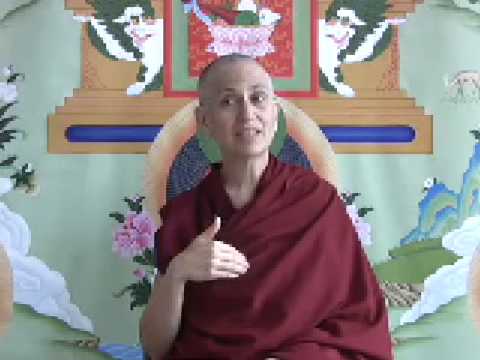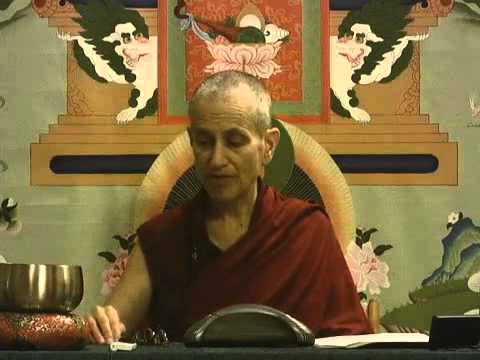Verse 38: Representations of the Buddha
Verse 38: Representations of the Buddha
Part of a series of talks on the 41 Prayers to Cultivate Bodhicitta from the Avatamsaka Sutra (the Flower Ornament Sutra).
- How to think while looking at statues of the Buddha
- Seeing a teacher as a representation of the Buddha
41 Prayers to cultivate bodhicitta: Verse 38 (download)
“May all beings be unimpeded in seeing all the Buddhas.”
This is the prayer of the bodhisattva when seeing someone meet a representation of the Buddha.
When we see somebody—like visitors come to the Abbey, or any of us—and they look at the statues, and look at the altars, and look at the paintings, and so on, then we can think,
“May all beings be unimpeded in seeing all the Buddhas.”
This is the prayer of the bodhisattva when seeing someone meet a representation of the Buddha.
When we sent out the Manjushri cards before the retreat, and when we have different events and we have a table with cards and representations of the Buddha and we give them out to people, this is what you can think when the people take these.
It’s said—I think on the great part of the Bodhisattva path of accumulation (I can’t remember well but I think that’s it)—by that time you have enough good karma that you can receive teachings from statues. I might be wrong. It might be a different level of the path. There’s one point where you can look at a statue or painting and receive a teaching, because you can see that within that statue or the painting, the Buddha’s omniscient mind is residing and the Buddha can teach you. In Tibet, before the Chinese occupation, they had a number of statues that could speak. Lots of magic there, but there were really statues that could speak. Do you ever have that feeling sometimes that there is a certain particular Buddhist statue which you can look at and its facial expression changes and you almost have the feeling like it could start talking to you? Sometimes you have that kind of feeling. When we have enough good karma and when our understanding of emptiness is deeper then that can probably happen.
[In response to audience] The question is, “Can you see a teacher as a representative of the Buddha?” Yes, definitely. In fact they say that is how we should train our minds. In terms of your Vinaya level teachers, the ones who give you refuge and the five precepts, you see them as a representative of the Buddha. The Buddha’s not here, so the Buddha sent a representative. In terms of the ones who teach the bodhisattva path and give you bodhisattva vows, then you see them as an emanation of the Buddha. When you are doing Tantric practice the teachers who give you initiation and the instructions, you see them as that deity, as that Buddha. It’s very much the same way.
Audience: There were three kinds of form bodies of the Buddha. There was the emanation body and the form body and then there was the body that appeared in the statues or an image of the Buddha.
Venerable Thubten Chodron (VTC): No. Within the emanation body there are different kinds. There’s the supreme emanation body, then there’s the one as an artisan or craftsman, and then, I think there’s the one as the statues. I think that is how it is.
Audience: That would be for all statues or just the occasional one?
VTC: All of them. They say that when you see a statue, try and think of it as an actual buddha, otherwise you’re bowing to a piece of metal. Then when people say you’re idol worshipping, maybe your mind is. If you really think that there’s an actual buddha there and you’re bowing to the Buddha, not to the piece of metal, then your mind really changes, doesn’t it?
We should always see these representations as representative of the Buddha. Otherwise we are idol worshippers, aren’t we? That’s why in our refuge vows, when it says when you see an image of the Buddha don’t discriminate: “This Buddha is beautiful, this buddha is not beautiful,” things like that. The Buddha’s form body is always beautiful. The artistry may be one way or the other, but the Buddha’s actual form body is always stupendous. That’s what we should practice seeing when we see an image. No matter whether the artistry of the image is nice or not. It’s just a way of making it so that we feel closer to the Three Jewels. Otherwise it seems like the Three Jewels are out somewhere far away.
Venerable Thubten Chodron
Venerable Chodron emphasizes the practical application of Buddha’s teachings in our daily lives and is especially skilled at explaining them in ways easily understood and practiced by Westerners. She is well known for her warm, humorous, and lucid teachings. She was ordained as a Buddhist nun in 1977 by Kyabje Ling Rinpoche in Dharamsala, India, and in 1986 she received bhikshuni (full) ordination in Taiwan. Read her full bio.


